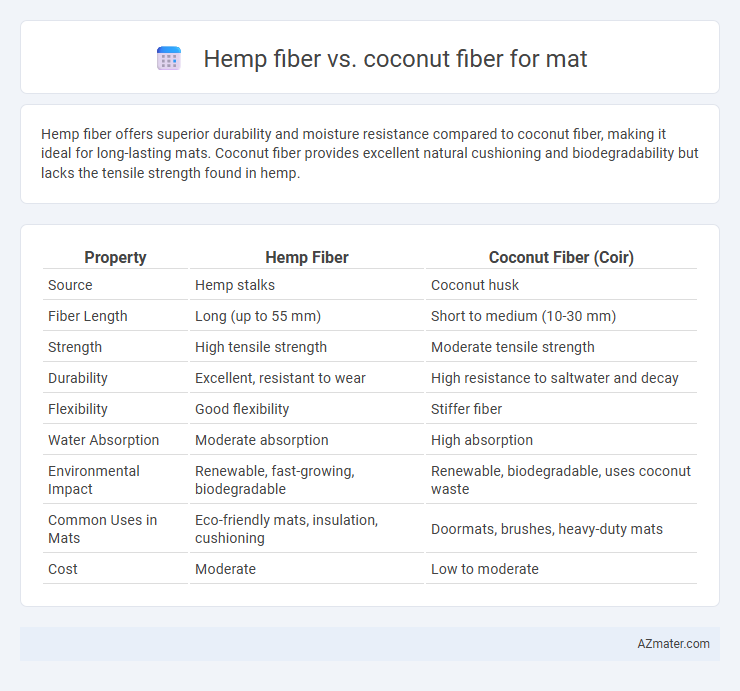Hemp fiber offers superior durability and moisture resistance compared to coconut fiber, making it ideal for long-lasting mats. Coconut fiber provides excellent natural cushioning and biodegradability but lacks the tensile strength found in hemp.
Table of Comparison
| Property | Hemp Fiber | Coconut Fiber (Coir) |
|---|---|---|
| Source | Hemp stalks | Coconut husk |
| Fiber Length | Long (up to 55 mm) | Short to medium (10-30 mm) |
| Strength | High tensile strength | Moderate tensile strength |
| Durability | Excellent, resistant to wear | High resistance to saltwater and decay |
| Flexibility | Good flexibility | Stiffer fiber |
| Water Absorption | Moderate absorption | High absorption |
| Environmental Impact | Renewable, fast-growing, biodegradable | Renewable, biodegradable, uses coconut waste |
| Common Uses in Mats | Eco-friendly mats, insulation, cushioning | Doormats, brushes, heavy-duty mats |
| Cost | Moderate | Low to moderate |
Introduction to Hemp and Coconut Fibers
Hemp fiber, derived from the stalks of the Cannabis sativa plant, is renowned for its strength, durability, and natural resistance to mold and UV rays, making it an excellent choice for mats. Coconut fiber, or coir, is processed from the outer husk of coconuts and is valued for its coarse texture, water resistance, and biodegradability. Both fibers offer sustainable alternatives for mat production, with hemp emphasizing longevity and Coconut fiber excelling in moisture management.
Origin and Sourcing of Hemp and Coconut Fibers
Hemp fiber, primarily sourced from the stalks of the Cannabis sativa plant, originates largely from regions such as China, Canada, and parts of Europe known for sustainable agricultural practices. Coconut fiber, or coir, comes from the outer husk of coconuts predominantly harvested in tropical countries like India, Sri Lanka, and the Philippines, where it serves as a vital agricultural byproduct. Both fibers are renewable, but hemp's rapid growth and lower water requirements offer an eco-friendly advantage in sustainable mat production.
Physical Properties: Strength and Durability
Hemp fiber exhibits superior tensile strength and durability compared to coconut fiber, making it ideal for long-lasting mats subjected to heavy use. Coconut fiber, while resilient and naturally water-resistant, generally offers lower tensile strength and tends to wear out faster under continuous abrasion. The high lignin content in coconut fiber provides good structural integrity, but hemp's higher cellulose concentration contributes to enhanced flexibility and toughness, resulting in mats with greater lifespan and load-bearing capacity.
Moisture Resistance and Absorption
Hemp fiber exhibits superior moisture resistance compared to coconut fiber, making it ideal for mats exposed to damp environments. While coconut fiber offers high absorption capacity, it tends to retain moisture longer, increasing the risk of mold and mildew. Hemp fiber's natural breathability and quick-drying properties enhance durability and maintain hygiene in moisture-prone settings.
Environmental Impact and Sustainability
Hemp fiber and coconut fiber both serve as eco-friendly materials for mats, but hemp fiber offers superior sustainability due to its rapid growth rate and lower resource requirements. Hemp cultivation uses less water and pesticides compared to coconut palm harvesting, which involves more intensive agricultural inputs and can impact soil resilience. Both fibers are biodegradable and renewable, yet hemp's ability to regenerate soil and absorb carbon dioxide enhances its positive environmental footprint over coconut fiber.
Cost and Market Availability
Hemp fiber typically costs more than coconut fiber due to its higher processing expenses and limited global cultivation compared to the abundant and widely available coir extracted from coconut husks. Coconut fiber dominates the market for mats due to its low price point and strong supply chain, especially in tropical regions where coconut palms are prevalent. Cost-effectiveness and consistent market availability make coconut fiber the preferred material for affordable and mass-produced mats, while hemp fiber is often reserved for premium, eco-friendly products.
Comfort and Texture Comparison
Hemp fiber offers a durable yet soft texture that provides excellent comfort and breathability for mats, making it ideal for prolonged use with a smooth, natural feel. Coconut fiber, derived from coir, is coarser and stiffer, delivering strong support and resilience but less softness, which may result in a rougher surface. The choice between hemp and coconut fiber mats depends on desired comfort, with hemp favored for softness and coconut preferred for robustness and moisture resistance.
Common Applications in Mat Manufacturing
Hemp fiber and coconut fiber both serve as popular materials in mat manufacturing, with hemp fiber favored for its durability and natural resistance to mold and mildew, making it ideal for indoor and outdoor mats. Coconut fiber, or coir, offers excellent water resistance and rough texture, commonly used in doormats and entrance mats to effectively remove dirt and moisture. Both fibers contribute to eco-friendly mat production, with hemp often utilized in high-performance, sustainable mats while coconut fiber is preferred for heavy-duty, rustic designs.
Maintenance and Longevity
Hemp fiber exhibits superior durability and resistance to mold and mildew, making mats made from hemp easier to maintain and longer-lasting compared to coconut fiber. Coconut fiber mats, derived from coir, tend to degrade faster due to their brittleness and absorbency, requiring more frequent replacement and careful cleaning to prevent deterioration. Hemp fiber's natural strength and moisture-wicking properties enhance the longevity and low-maintenance characteristics of mats in high-traffic or humid environments.
Conclusion: Choosing the Right Fiber for Mats
Hemp fiber offers superior durability, moisture resistance, and antimicrobial properties, making it ideal for long-lasting mats in high-traffic or damp environments. Coconut fiber, or coir, provides excellent natural cushioning and drainage, suitable for outdoor or decorative mats requiring eco-friendly materials. Selecting the right fiber depends on the specific use-case: opt for hemp for strength and hygiene, and coconut fiber for comfort and biodegradability.

Infographic: Hemp fiber vs Coconut fiber for Mat
 azmater.com
azmater.com